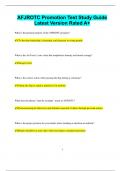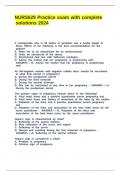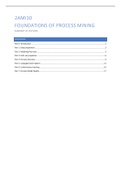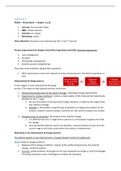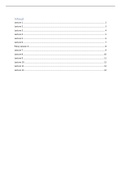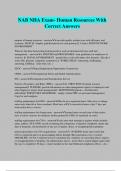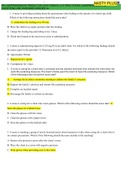Risk Management
2020 – Corona Edition – Annie
1
,Contents
1. Introduction .................................................................................................................................................. 6
1.1. Risk management? .................................................................................................................................. 6
1.2. Tools for risk management..................................................................................................................... 6
1.3. Risk drivers – Example: Solvency II framework.................................................................................... 7
1.4. Risk Management is, or should be, a core skill for all companies ..................................................... 7
1.5. Different stakeholders, different views ................................................................................................ 8
1.6. Recent financial scandals…..................................................................................................................... 8
1.7. The Madoff case - Different perspectives ............................................................................................ 8
2. The credit Crisis of 2007 & CDO’s (Chapter 6) ....................................................................................... 10
2.1. The U.S. Housing Market ...................................................................................................................... 10
2.1.1. The Relaxation of Lending Standards ............................................................................................. 10
2.1.2. The Bubble Bursts ............................................................................................................................. 11
2.2. Securitization ......................................................................................................................................... 12
2.2.1. Asset Backed Security (Simplified) .................................................................................................. 13
2.2.2. The Waterfall ..................................................................................................................................... 14
2.2.3. ABS CDOs or Mezz CDOs (Simplified) ............................................................................................. 15
2.2.4. What happened… .............................................................................................................................. 16
2.3.3. Role of Incentives .............................................................................................................................. 18
2.3.4. Importance of Transparency ........................................................................................................... 18
2.4. What changed afterwards .................................................................................................................... 18
2.5. Lessons from the Crisis ........................................................................................................................ 19
3. Measuring risk: Univariate Modelling ..................................................................................................... 20
3.1. Cumulative distribution functions (continuous vs discrete) ................ Error! Bookmark not defined.
3.2. Other possibilities? ................................................................................................................................ 20
3.3. Features of distributions....................................................................................................................... 20
3.11. Example: BEL 20 stock index............................................................................................................ 23
3.12. Risk measures .................................................................................................................................... 26
3.13. Value-at-risk ....................................................................................................................................... 26
3.15. Risk measures .................................................................................................................................... 28
3.16. Value-at-risk is not coherent ........................................................................................................... 29
3.18. Excel sheet ......................................................................................................................................... 31
4. Credit risk & Estimating Default Probabilities (Chapter 19) ................................................................. 33
4.1. Introduction ........................................................................................................................................... 33
4.2. Credit Ratings ......................................................................................................................................... 33
4.2.1. Internal Credit Ratings ...................................................................................................................... 34
Estimating Default Probabilities ....................................................................................................................... 34
Historical Data ..................................................................................................................................................... 34
2
,4.2.2. Altman’s Z-score (Manufacturing companies) .............................................................................. 34
4.3. Historical Default Probabilities ............................................................................................................ 35
Rating migration ................................................................................................................................................. 36
Interpretation...................................................................................................................................................... 36
Do default probabilities increase with time? .................................................................................................. 36
4.4. Hazard rates ........................................................................................................................................... 36
4.4.1. Conditional default probability........................................................................................................ 36
4.4.2. Hazard Rate ........................................................................................................................................ 36
4.4.3. Properties of Hazard rates ............................................................................................................... 37
4.5. Recovery Rates - p. 404 ........................................................................................................................ 38
4.6. Credit Default Swaps (p.404-409) ....................................................................................................... 39
4.6.1. Attractions of the CDS Market ........................................................................................................ 41
4.6.2. Concerns with the CDS Market ....................................................................................................... 41
4.6.3. The Cheapest-to-Deliver Bond ........................................................................................................ 41
4.6.4. Credit Indices ..................................................................................................................................... 41
4.6.5. The Use of Fixed Coupons ................................................................................................................ 42
4.7. Credit spreads ........................................................................................................................................ 42
4.7.1. CDS Spreads and Bond Yields .......................................................................................................... 42
4.7.2. Relation between Credit Default Swaps and Bond Yields ............................................................ 43
4.7.3. The Risk-Free Rate ............................................................................................................................ 43
4.7.4. Asset Swaps........................................................................................................................................ 44
4.7.5. CDS-Bond Basis .................................................................................................................................. 44
4.8. Using CDS Prices to Predict Default Probabilities.............................................................................. 45
4.8.1. Approximate calculation .................................................................................................................. 45
4.9. Estimating PD’s from bonds ................................................................................................................. 45
4.10. Comparison of default probability estimates ................................................................................ 48
4.10.1. The Data ............................................................................................................................................. 48
4.10.2. Real World vs Risk Neutral Default Probabilities, 7 year averages ............................................. 49
4.10.3. Risk Premiums Earned By Bond Traders ........................................................................................ 50
4.10.4. Possible Reasons for These Results ................................................................................................ 50
4.10.5. Which World Should We use? ......................................................................................................... 51
4.11. Current sovereign spreads ............................................................................................................... 52
4.12. Merton model.................................................................................................................................... 54
(Section 19.8: USING EQUITY PRICES TO ESTIMATE DEFAULT PROBABILITIES , pages 419 422) ............. 54
4.12.1. Introduction ....................................................................................................................................... 54
4.12.2. Equity vs. Assets ................................................................................................................................ 54
4.12.3. Volatilities ........................................................................................................................................... 55
4.12.4. Distance to default ............................................................................................................................ 55
3
,4.12.5. Extensions of the basic model ......................................................................................................... 56
4.12.6. Performance of the Model .............................................................................................................. 57
4.12.7. Getting real-world PD’s .................................................................................................................... 57
4.12.8. Risk-neutral vs. Real World in Merton’s model ............................................................................. 58
4.13. Summary ............................................................................................................................................ 58
5. Basel I and Basel II (Chapter 15)............................................................................................................... 59
5.1. The reasons for regulating banks ........................................................................................................ 59
A. Basel I .......................................................................................................................................................... 60
History of Bank Regulation ................................................................................................................................ 60
5.2. Bank regulation Pre-1988 ..................................................................................................................... 60
5.3. 1988: BIS Accord (page 327-330) ........................................................................................................ 61
5.3.1. The Cooke Ratio ................................................................................................................................ 61
5.3.2. Risk-Weighted Capital (Credit risk) ................................................................................................. 62
5.3.3. Credit Equivalent Amount for Derivatives ..................................................................................... 62
5.3.4. Add-on Factors as a % of Principal for Derivatives ...................................................................... 63
5.3.5. Example with off-balance sheet items ........................................................................................... 63
5.3.6. Final formula for RWA ...................................................................................................................... 64
5.3.7. Types of Capital ................................................................................................................................ 64
5.4. G-30 Policy Recommendations ............................................................................................................ 65
5.5. Netting ................................................................................................................................................... 65
5.6. 1996 Amendment.................................................................................................................................. 67
5.6.1. The 1996 Amendment - Market Risk Capital (1996) .................................................................... 68
5.6.2. The 1996 Amendment – Total Capital ............................................................................................ 69
B. Basel II ......................................................................................................................................................... 70
5.7. Credit Risk Capital Under Basel II ........................................................................................................ 71
5.7.1. Changes to Capital Requirements ................................................................................................... 71
5.7.2. Basel II – standardized approach .................................................................................................... 71
5.7.3. Ratings and PD’s ................................................................................................................................ 72
5.7.4. Basel II IRB Approach for corporate, banks and sovereign exposures ....................................... 73
5.7.5. Foundation IRB versus Advanced IRB ............................................................................................. 74
5.7.6. The model used by regulators ......................................................................................................... 74
5.7.7. Key model (Gaussian Copula) .......................................................................................................... 74
5.7.8. Numerical Results for WCDR ........................................................................................................... 75
5.7.9. Corporate, Sovereign, and Bank Exposures - dependence of ρ on PD...................................... 77
5.7.10. Extension ............................................................................................................................................ 78
6. Multivariate Modelling – Portfolios of risks ........................................................................................... 79
6.1. Diversification ........................................................................................................................................ 79
6.1.1. Diversification - Two risks ................................................................................................................ 79
4
,6.2. The multivariate normal distribution .................................................................................................. 82
6.3. Decomposing the multivariate normal distribution.......................................................................... 83
6.4. Modelling (generating) multivariate normal risks ............................................................................. 85
6.5. General risks: problems with linear correlation ................................................................................ 86
6.6. General risks: mapping risks and Kendall’s tau.................................................................................. 88
6.7. Modelling dependence with copulas – the bivariate case ............................................................... 89
6.7.1. Tails and tail dependences ............................................................................................................... 89
6.7.2. Ordered pairs ..................................................................................................................................... 91
6.7.3. Quantile mapping.............................................................................................................................. 91
6.8. Modelling dependence with copulas – the multivariate case ......................................................... 92
7. Excel file: Portfolio VaR with copula – purely HOC note’s .................................................................... 93
8. Economic Capital and RAROC – Chapter 26 ........................................................................................... 99
8.1. Definition of economic capital ............................................................................................................. 99
8.1.1. Unexpected loss and Capital.......................................................................................................... 100
8.1.3. Required capital at different entity levels.................................................................................... 101
8.1.4. Approaches to measurement ........................................................................................................ 101
8.2. Characteristics of Distributions.......................................................................................................... 103
8.3. Components of economic capital ...................................................................................................... 104
8.3.1. Market Risk Economic Capital ....................................................................................................... 104
8.3.2. Credit Risk Economic Capital ......................................................................................................... 105
8.3.3. Operational Risk Economic Capital ............................................................................................... 107
8.4. Shapes of the loss distributions ......................................................................................................... 107
8.5. Relative importance of risks ............................................................................................................... 108
8.5.1. Interaction between risks .............................................................................................................. 108
8.6. Aggregating economic capital ............................................................................................................ 108
8.6.1. Naïve approach – need for diversification ................................................................................... 108
8.6.2. Assuming Normal Distributions ..................................................................................................... 109
8.6.3. Using copulas ................................................................................................................................... 110
8.6.4. The hybrid approach – ‘ a practical approach’ – very common! Used in Solvency II ............. 110
8.7. Allocation of economic capital........................................................................................................... 112
8.7.1. Strictly proportional ........................................................................................................................ 112
8.7.2. Marginal contribution..................................................................................................................... 112
8.7.3. Euler rule => used most often ....................................................................................................... 112
8.8. RAROC ................................................................................................................................................... 113
8.8.2. Importance of capital allocation Ex-ante and Ex-post................................................................ 114
8.9. Summary ............................................................................................................................................... 115
5
,1. Introduction
1.1. Risk management?
• What is risk?
• What can go wrong? ➔ Risk drivers
• How likely is this? ➔ Probabilities
• If it does, how bad can it get? ➔ Impact/loss
• In this course we focus on risk faced by companies, with a particular emphasis on:
▪ Financial institutions (as opposed to corporates)
▪ Financial risk (as opposed to operational risk, reputational risk,....)
• However most of the concepts and tools developed are applicable in a more general context.
1.2. Tools for risk management
• A risk is characterised through:
▪ Set of outcomes: these are the impacts of scenarios that may occur during a selected
timeframe (the horizon).
▪ Probabilities of these outcomes.
• Mathematically: a risk is a random variable.
6
,1.3. Risk drivers – Example: Solvency II framework
1.4. Risk Management is, or should be, a core skill for all companies
• Risk management is an inherent part of running any business:
▪ Shareholders want a good balance between return (opportunity) and volatility (danger)
▪ Avoiding bankruptcy or a rating downgrade is of crucial importance for any company and
needs to be dealt with as well.
• Note that for the financial industry, it is even more important for the following reason:
▪ Insolvency may have a big impact on the (global) economy
7
,1.5. Different stakeholders, different views
1.6. Recent financial scandals….
…. are, at least partially, due to inadequate risk taking and management
1.7. The Madoff case - Different perspectives - https://www.youtube.com/watch?v=IymklQKT-lc&ab_channel=AlJazeeraEnglish
8
,1.8. Extra: The Madoff case – Wikipedia (not in class)
The Madoff investment scandal was a major case of stock and securities fraud discovered in late 2008.
In December of that year, Bernie Madoff, the former NASDAQ chairman and founder of the Wall Street
firm Bernard L. Madoff Investment Securities LLC, admitted that the wealth management arm of his
business was an elaborate multi-billion-dollar Ponzi scheme.
Madoff founded Bernard L. Madoff Investment Securities LLC in 1960, and was its chairman until his
arrest. The firm employed Madoff's brother Peter as senior managing director and chief compliance
officer, Peter's daughter Shana Madoff as rules and compliance officer and attorney, and Madoff's
sons Mark and Andrew. Peter was sentenced to 10 years in prison, and Mark died by suicide exactly
two years after his father's arrest. Alerted by his sons, federal authorities arrested Madoff on
December 11, 2008. On March 12, 2009, Madoff pleaded guilty to 11 federal crimes and admitted to
operating the largest private Ponzi scheme in history. On June 29, 2009, he was sentenced to 150 years
in prison with restitution of $170 billion. According to the original federal charges, Madoff said that his
firm had "liabilities of approximately US$50 billion". Prosecutors estimated the size of the fraud to be
$64.8 billion, based on the amounts in the accounts of Madoff's 4,800 clients as of November 30, 2008.
Ignoring opportunity costs and taxes paid on fictitious profits, half of Madoff's direct investors lost no
money, with Madoff's repeated (and repeatedly ignored) whistle-blower, Harry Markopolos,
estimating that at least $35 billion of the money Madoff claimed to have stolen never really existed,
but was simply fictional profits he reported to his clients. Investigators determined that others were
involved in the scheme. The U.S. Securities and Exchange Commission (SEC) was criticized for not
investigating Madoff more thoroughly. Questions about his firm were raised as early as 1999. The
legitimate trading arm of Madoff's business that was run by his two sons was one of the top market
makers on Wall Street, and in 2008 was the sixth-largest.
Madoff's personal and business asset freeze created a chain reaction throughout the world's business
and philanthropic community, forcing many organizations to at least temporarily close, including the
Robert I. Lappin Charitable Foundation, the Picower Foundation, and the JEHT Foundation
--------------------------------------------------------------------------------------------------------------------------------------
In the video Peter finds the SEC does more harm than good. It creates a barrier for smaller firms to
enter (very expensive) and the big firms can comply easier with these rules.
Margie finds that both the SEC as the investors are to blame. They should have had much deeper due
diligence and look closer to what was going on and the SEC had to pick this up sooner or dug deeper.
Sam believed that the firm was legit up till 2001. But when investors wanted to keep seeying these high
returns which let to what happened… Banks, social security, etc. is a Ponzi scheme, literally everything,
it’s a very grey line. Sam agrees and he says the US government is the largest Ponzi scheme, everything
is, you pay back old investors with new money. And it doesn’t work any better with the government
then when private companies are doing it. What unravelled the Madoff scandal is that investors wanted
their money back and what’s happening now is the Chinese who want to have an economic stimulus, a
lot of US’s creditors want their money back but they can’t have it! If people stop lending Americans the
US government money the whole system will fall apart just like the Madoff scam.
Margie finds that the people went in and it wasn’t defined as a Ponzi scheme and they thought it was
legitimate and it’s just not okay. Sam says that the government is to blame for creating this feeling of
security because of the SEC, while if it wasn’t there people would have maybe been more cautious.
Everyone: It is impossible to get this high return year after year, the people really diluted themselves.
9
, 2. The credit Crisis of 2007 & CDO’s (Chapter 6)
Starting in 2007, the United States experienced the worst financial crisis since the 1930s. The crisis
spread rapidly from the United States to other countries and from financial markets to the real
economy. Some financial institutions failed. Many more had to be bailed out by national
governments. The first decade of the twenty first century was disastrous for the financial sector, and
the risk management practices of financial institutions have been subjected to a great deal of criticism.
As we will see in later chapters, the crisis led to a major overhaul of the way financial institutions are
regulated. This chapter examines the origins of the crisis, what went wrong, why it went wrong, and
the lessons that can be learned. In the course of the chapter, we will find out about the U.S. housing
market, asset-backed securities, and collateralized debt obligations.
2.1. The U.S. Housing Market
A natural starting point for a discussion of the credit crisis of 2007 is the U.S. housing market. The figure
below shows the S&P/Case-Shiller composite-10 index for house prices in the United States between
January 1987 and March 2014. This tracks house prices for ten major metropolitan areas in the United
States. In about the year 2000, house prices started to rise much faster than they had in the previous
decade. The very low level of interest rates between 2002 and 2005 was an important contributory
factor, but the bubble in house prices was largely fuelled by mortgage lending practices. The 2000 to
2006 period was characterized by a huge increase in what is termed subprime mortgage lending.
Subprime mortgages are mortgages that are considered to be significantly more risky than average.
Before 2000, most mortgages classified as subprime were second mortgages. After 2000, this changed
as financial institutions became more comfortable with the notion of a subprime first mortgage.
2.1.1. The Relaxation of Lending Standards
!Mortgage lenders in the United States started to relax their lending standards in about 2000. This
made house purchases possible for many families that had previously been considered to be not
sufficiently creditworthy to qualify for a mortgage. These families increased the demand for real estate
and prices rose. To mortgage brokers and mortgage lenders, the combination of more lending and
rising house prices was attractive. More lending meant bigger profits. Rising house prices meant that
the lending was well covered by the underlying collateral. If the borrower defaulted, the resulting
foreclosure would lead to little or no loss.!
10


